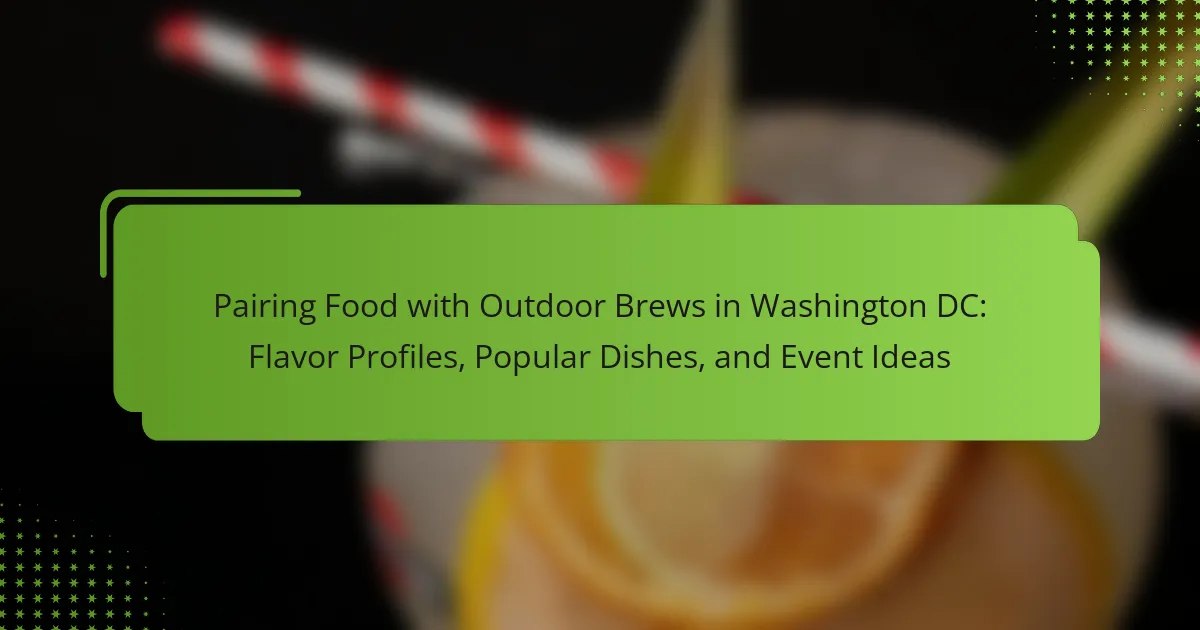Pairing food with outdoor brews in Washington DC enhances the drinking experience, with popular combinations including barbecue with IPAs, tacos with lagers, and pretzels with various beers. Local events such as the DC Beer Festival, National Cherry Blossom Festival, and H Street Festival showcase these food and drink pairings, highlighting the city’s vibrant culinary culture. To optimize these pairings, consider flavor profiles, seasonal ingredients, temperature, and the use of garnishes. Engaging with local breweries for pairing recommendations can further enrich the outdoor dining experience.

What are the best food pairings with outdoor brews in Washington DC?
The best food pairings with outdoor brews in Washington DC include barbecue, tacos, and pretzels. Barbecue complements the hoppy flavors of IPAs. Tacos offer a spicy contrast to lighter lagers. Pretzels provide a salty snack that pairs well with various beers. These pairings enhance the outdoor drinking experience. Local breweries often recommend these combinations for optimal flavor.
How do flavor profiles influence food and beer pairings?
Flavor profiles significantly influence food and beer pairings by determining how well the tastes complement or contrast each other. For instance, a hoppy IPA pairs well with spicy foods due to its bitterness balancing the heat. Conversely, a malty stout can enhance the richness of chocolate desserts. The sweetness in certain beers can also counterbalance salty dishes, creating a harmonious experience. Various styles of beer, such as lagers, ales, and stouts, possess unique flavor profiles that interact differently with food. Research indicates that pairing complementary flavors enhances the overall dining experience. This principle is supported by studies showing that balanced flavor interactions lead to higher satisfaction levels among consumers.
What are the primary flavor profiles found in outdoor brews?
The primary flavor profiles found in outdoor brews include hoppy, malty, fruity, and spicy. Hoppy flavors are characterized by bitterness and aromatic notes from hops. Malty profiles often present sweetness and body from malted grains. Fruity flavors can range from citrus to berry, depending on the yeast and ingredients used. Spicy notes may come from certain yeast strains or added spices. These profiles enhance the overall drinking experience, especially in outdoor settings. Many breweries in Washington DC emphasize these flavors to complement local cuisine.
How can flavor profiles of food complement outdoor brews?
Flavor profiles of food can enhance outdoor brews by creating harmonious taste experiences. Complementary flavors can balance the bitterness of certain brews. For example, citrusy IPAs pair well with grilled seafood. Rich stouts can be complemented by chocolate desserts. Spicy foods often match with hoppy ales to create a contrast. Additionally, fruity beers can elevate dishes like salads with berries. Studies show that food and drink pairings can enhance overall enjoyment. A well-paired meal can increase the perception of flavor intensity.
What popular dishes are commonly paired with outdoor brews?
Popular dishes commonly paired with outdoor brews include burgers, hot dogs, and barbecue. Burgers offer a hearty complement to various beer styles. Hot dogs are a classic choice for casual outdoor gatherings. Barbecue dishes, such as ribs or pulled pork, enhance the flavors of many ales and lagers. Other popular options are nachos and pretzels, which provide a savory snack. Each of these dishes pairs well with the refreshing qualities of outdoor brews, making them ideal for social events.
Which local dishes in Washington DC pair well with craft beers?
Local dishes in Washington DC that pair well with craft beers include Maryland crab cakes, half-smokes, and fried chicken. Maryland crab cakes offer a rich, savory flavor that complements hoppy beers. Half-smokes, a local sausage, provide a spicy kick that matches well with malty brews. Fried chicken’s crispy texture and seasoning enhance the refreshing qualities of lighter ales. These pairings are popular among locals and visitors alike. The combination of flavors enhances the overall dining experience.
What seasonal dishes enhance the outdoor brewing experience?
Seasonal dishes that enhance the outdoor brewing experience include grilled meats, fresh salads, and seasonal vegetables. Grilled meats like sausages and burgers pair well with various brews. Fresh salads with local greens provide a light complement to heavier beers. Seasonal vegetables, such as corn and zucchini, add vibrant flavors to the meal. These dishes are often chosen for their ability to balance the richness of beers. The combination of smoky, fresh, and vibrant tastes creates a harmonious outdoor dining experience. Pairing these foods with specific brews can elevate the overall enjoyment of the outdoor brewing event.
How do cultural influences shape food and drink pairings in DC?
Cultural influences shape food and drink pairings in DC by integrating diverse culinary traditions. The city’s multicultural population enhances the variety of available cuisines. For example, Ethiopian cuisine often pairs with honey wine, reflecting its cultural heritage. Similarly, Latin American dishes frequently complement craft beers, showcasing regional flavors. Asian influences introduce unique pairings, such as sushi with sake. Seasonal festivals celebrate these cultural connections, highlighting traditional pairings. The presence of international restaurants further diversifies pairing options. Local events often feature food and drink collaborations that honor cultural backgrounds. This blend of traditions creates a rich tapestry of flavors in DC’s dining scene.
What role does local cuisine play in pairing with outdoor brews?
Local cuisine enhances the experience of pairing with outdoor brews by complementing flavors. Dishes from the region often feature ingredients that resonate with local beer profiles. For instance, a spicy crab cake pairs well with a hoppy IPA. The freshness of local produce also elevates the taste of lighter ales. Seasonal ingredients reflect the essence of the area, creating a harmonious dining experience. Additionally, cultural influences in local cuisine can introduce unique flavor combinations. This synergy between food and drink fosters a deeper appreciation for both. Studies show that food and beer pairings can enhance overall enjoyment by up to 30%.
How do international influences affect beer and food pairings?
International influences shape beer and food pairings by introducing diverse flavor profiles and cultural practices. Global ingredients and brewing techniques enhance local culinary traditions. For example, Belgian beers often pair well with rich, creamy cheeses due to their complex flavors. Similarly, Asian cuisines frequently utilize spices that complement the crispness of lagers or the bitterness of IPAs. The fusion of different culinary traditions leads to innovative pairings. Research shows that cultural exposure increases the appreciation of unique flavor combinations. This dynamic interaction enriches the dining experience and broadens consumer choices.

What events showcase food and outdoor brews in Washington DC?
Events that showcase food and outdoor brews in Washington DC include the DC Beer Festival and the National Cherry Blossom Festival. The DC Beer Festival features local breweries and food vendors. It typically occurs in the fall and spring. The National Cherry Blossom Festival includes various food and drink events. These events celebrate the blooming of cherry blossoms with cultural activities. Additionally, the H Street Festival offers local food and craft beer. It takes place annually in September. Each of these events highlights the vibrant food and brew culture in the city.
Which festivals highlight food and outdoor brewing experiences?
Food and outdoor brewing experiences are highlighted at several festivals in Washington DC. Notable festivals include the DC Beer Festival, which features local breweries and food vendors. The Capital City Brew Fest also showcases craft beer alongside food pairings. Another significant event is the National Cherry Blossom Festival, where food trucks and breweries participate. The DC Food Truck Festival combines various cuisines with local brews. Each festival emphasizes the connection between food and craft beverages, enhancing the outdoor experience.
What activities can enhance the enjoyment of food and brews at these events?
Interactive tastings can enhance the enjoyment of food and brews at these events. Participants can sample various food and beverage pairings. Guided tastings led by experts can provide valuable insights. Cooking demonstrations can showcase how to prepare dishes that complement specific brews. Live music can create a lively atmosphere, encouraging social interaction. Food contests can engage attendees and highlight local culinary talent. Workshops on brewing techniques can deepen appreciation for the craft. Lastly, themed events can focus on regional flavors, enriching the overall experience.
How can you organize a successful outdoor brew and food event?
To organize a successful outdoor brew and food event, start by selecting an appropriate venue. Ensure the location has ample space for attendees and food vendors. Next, obtain necessary permits and licenses for serving alcohol and food. Collaborate with local breweries and food trucks to offer a diverse selection of brews and dishes. Promote the event through social media and local community boards to attract a larger audience. Provide seating and shade areas for comfort during the event. Implement a clear layout for food and drink stations to facilitate smooth traffic flow. Finally, consider incorporating entertainment such as live music to enhance the atmosphere. These strategies contribute to a well-organized and enjoyable event experience.
What are the key elements to consider when planning an outdoor pairing event?
Key elements to consider when planning an outdoor pairing event include venue selection, weather considerations, and food and beverage compatibility. The venue must accommodate guests comfortably and provide a suitable atmosphere. Weather conditions can impact attendance and enjoyment, so contingency plans are essential. Food and beverage compatibility ensures that flavors complement each other, enhancing the overall experience. Additionally, logistical aspects like seating arrangements, accessibility, and sanitation facilities are crucial for guest convenience. Event timing should align with peak attendance periods to maximize participation. Finally, marketing strategies should effectively promote the event to reach the target audience.
How can you engage attendees in food and brew pairings?
Engage attendees in food and brew pairings by offering interactive tastings. Provide small samples of food and various brews for attendees to try together. Educate them on flavor profiles that complement each other. Host guided pairing sessions led by experts to explain choices. Encourage attendees to share their experiences and preferences. Use visual aids to highlight key flavor notes. Collect feedback to refine future events. Studies show that interactive experiences enhance engagement and retention.

What tips can enhance your outdoor brew and food pairing experience?
To enhance your outdoor brew and food pairing experience, consider the following tips. First, match the brew’s flavor profile with the food’s taste. For example, hoppy IPAs complement spicy dishes well. Second, consider the seasonality of ingredients. Fresh, local produce can elevate the overall experience. Third, experiment with contrasting flavors. A rich stout can balance out a sweet dessert. Fourth, pay attention to the temperature of both the brew and food. Cold beers pair well with grilled meats. Fifth, utilize garnishes and herbs to enhance aromas. Fresh herbs can elevate both food and drink. Lastly, engage with local breweries for pairing suggestions. They often provide unique insights based on their offerings.
How can you select the right outdoor brew for your meal?
To select the right outdoor brew for your meal, consider the flavor profile of both the food and the brew. Match lighter dishes with lighter brews like pilsners or wheat beers. Pair richer, heavier meals with robust brews such as stouts or IPAs.
For example, grilled chicken goes well with a pale ale, while barbecued ribs are complemented by a brown ale. Seasonal ingredients in your meal can also guide your brew choice. Fresh summer salads may pair nicely with a fruity saison, while hearty winter stews align with dark lagers.
The right brew enhances the dining experience by balancing flavors. Research indicates that complementary pairings can elevate the overall taste (source: “The Science of Beer and Food Pairing,” Journal of Culinary Science & Technology).
What factors should you consider when choosing a brew for specific dishes?
When choosing a brew for specific dishes, consider flavor compatibility, aroma, and body. Flavor compatibility ensures the brew enhances or complements the dish’s taste. For example, hoppy beers pair well with spicy foods. Aroma can influence the overall dining experience. A brew with citrus notes can elevate seafood dishes. The body of the brew affects mouthfeel and richness. Lighter beers suit delicate dishes, while fuller-bodied brews match hearty meals. Additionally, the brew’s alcohol content can impact the dish’s flavor perception. Lower alcohol content is often preferred with lighter fare. These factors collectively create a harmonious pairing experience.
What common mistakes should you avoid in food and brew pairings?
Common mistakes to avoid in food and brew pairings include ignoring flavor balance. Pairing a heavy dish with a light brew can lead to an unbalanced experience. Another mistake is not considering the brew’s carbonation level. High carbonation can overpower delicate flavors in food. Additionally, overlooking complementary flavors can result in a mismatch. For instance, pairing spicy food with a bitter brew may enhance the heat unpleasantly. Lastly, serving food and brew at incorrect temperatures can diminish their qualities. For example, warm beer with cold food can disrupt the tasting experience.
How can over- or under-pairing affect the dining experience?
Over-pairing or under-pairing can significantly diminish the dining experience. Over-pairing occurs when the flavors of food and drink clash, overwhelming the palate. This can lead to a lack of enjoyment and hinder the appreciation of individual flavors. Under-pairing, on the other hand, may result in a lack of harmony between the food and drink. This can cause the meal to feel incomplete or unbalanced. Research indicates that proper pairing enhances flavor perception and overall satisfaction. For instance, a study published in the Journal of Culinary Science & Technology emphasizes that complementary flavors improve the dining experience. Therefore, achieving the right balance in pairing is crucial for an enjoyable meal.
What are the best practices for balancing flavors in pairings?
Balancing flavors in pairings involves matching complementary and contrasting tastes. Start by identifying the dominant flavor of the dish or brew. Use ingredients that enhance or balance that flavor. For example, a hoppy beer pairs well with rich, fatty foods, as the bitterness cuts through the richness. Conversely, a sweet brew can complement spicy dishes, providing a soothing contrast. Consider acidity as well; acidic foods can brighten the flavors of a beer. Additionally, texture plays a role; pairing crunchy foods with smooth brews can create an enjoyable contrast. Experimentation is key; try different combinations to find what works best for your palate.
The main entity of this article is the pairing of food with outdoor brews in Washington DC. It explores the best food pairings, including barbecue, tacos, and pretzels, highlighting how flavor profiles influence these combinations. The article discusses popular local dishes that complement craft beers, seasonal options for outdoor events, and cultural influences shaping the dining scene. Additionally, it provides insights on organizing successful food and brew events, engaging attendees, and best practices for balancing flavors in pairings.
